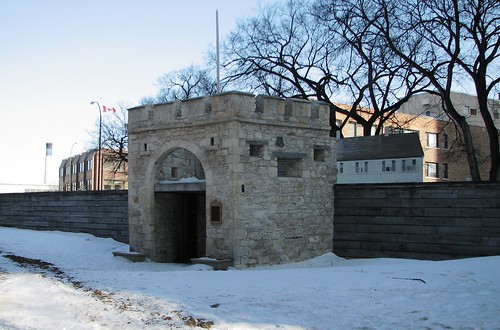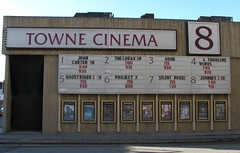 August 21, 1919
– The town of Portage la Prairie is the first applicant to receive
power under the 1919 Electrical Power Transmission Act. On this day it
is connected to the Manitoba Power Commission’s electrical grid at the
Scotland Avenue Substation in Winnipeg.
August 21, 1919
– The town of Portage la Prairie is the first applicant to receive
power under the 1919 Electrical Power Transmission Act. On this day it
is connected to the Manitoba Power Commission’s electrical grid at the
Scotland Avenue Substation in Winnipeg. August 21, 1981 - The Towne Cinema 8 on Notre Dame Avenue opens. It was Canada's first stand-alone multiplex cinema.
August 21, 1935 - Marjorie White, 27, dies in a car crash near Hollywood.
Born Marjorie Guthrie in Winnipeg in 1904, she began performing at age 4 in a touring song and dance group called the Winnipeg Kiddies. From there it was to the vaudeville circuit where she was partnered with Thelma White (no relation) as the White Sisters.
Marjorie's film career had just begun with parts opposite the Three Stooges and Will Rogers when she died. (For more.)
August 21, 1957 - Chris Kelekis, founder of C. Kelekis' restaurant dies.
August 21, 1907 - The Morning Telegram ceases publication after a nine-year run.
 August 21, 1897 - The HBC presents the Upper Fort Garry Gate to the City of Winnipeg. It was in such bad condition that some thought it a
'backhanded gift', the HBC offloading an expensive relic to the city to fix up. The gate will soon be the centrepeice of an interpretive park.
August 21, 1897 - The HBC presents the Upper Fort Garry Gate to the City of Winnipeg. It was in such bad condition that some thought it a
'backhanded gift', the HBC offloading an expensive relic to the city to fix up. The gate will soon be the centrepeice of an interpretive park.August 21 1936 - John Pawluk, 49, is hanged at Headingly for the murder of his wife Julia.
Pawluk was not a nice character. The Ukrainian-born labourer had a police record that included assault, selling moonshine and weapons charges. By 1927 he was living in Gonor, MB on a small farm with a second-hand store.
On November 5, 1935 Pawluk's wife Julia disappeared. He told some neighbours that he didn't know where she went and others that he awoke that morning to find her dressed and leaving the house, (she had walked out on Pawluk a number of times before.)
A few days after the disappearance, John approached Selkirk's Reeve to inquire about placing their children, aged 2, 12 and 14 year old, in foster care. The Reeve later testified that “we were afraid to go to his house because we knew that he had killed her.”
At
around the same time, a male friend of Julia's in East Selkirk
received the above letter saying that she had found another man and
simply had to leave. Julia’s sister Minnie noticed that the note, though written in Ukrainian, was not in her sister's handwriting.
Suspicion
mounted but it was John who gave himself away. High on home-brew
one day, he told a neighbour that he had shot his wife in the head
and buried her in the farm’s manure pile. This was relayed to the
Selkirk R.C.M.P.. and on March 28, 1936 they searched the farm and found Julia's body, shot in the head and under a manure pile.
Initially
arrested on weapons charges, Pawluk was charged with murder on
March 30, 1936 and transferred from Selkirk to Winnipeg. Pawluk
summoned Selkirk RCMP's Corporal James Newman and gave a statement
that he had killed his wife but could not remember the circumstances.
Drunk on moonshine on the evening of November 4th, he recalled that
they argued but could not remember if he hit her or shot her.
As if John was not in enough trouble, RCMP began re-examining the suspicious suicide of Pawluk's neighbour, Genio Bulega, just one week prior to finding Julia's body.
As if John was not in enough trouble, RCMP began re-examining the suspicious suicide of Pawluk's neighbour, Genio Bulega, just one week prior to finding Julia's body.
Bulega
was found dead from a gunshot wound to the head, the trigger of the
shotgun tied to his foot to make it look like suicide. On the table
a typewritten, cryptic note supposedly from Bulega saying that
“she” had been bugging him about running away together since the
summer and his heart couldn’t stand it anymore. Please don’t bother
“him” about his wife because “he” is not to blame. No actual names
were used.
At the inquest into Bulega’s death it was noted that the letter, which had been folded into four and stuck to the kitchen table with a knife, had blood spatter outside AND inside the folds meaning that it was open at the time of the shooting. There were no fingerprints on the gun. Eventually Pawluk was charged with Bulega’s murder, though never tried for it.
Court sat through the summer. In his court appearances it was noted that he seemed unbothered and usually had a smile for friends who came to watch the proceedings. Pawluk took the stand and recanted his confession to Cpl. Newman, claiming that he had lent his shotgun to the neighbour - the one who squealed to the RCMP about the manure pile.
At the inquest into Bulega’s death it was noted that the letter, which had been folded into four and stuck to the kitchen table with a knife, had blood spatter outside AND inside the folds meaning that it was open at the time of the shooting. There were no fingerprints on the gun. Eventually Pawluk was charged with Bulega’s murder, though never tried for it.
Court sat through the summer. In his court appearances it was noted that he seemed unbothered and usually had a smile for friends who came to watch the proceedings. Pawluk took the stand and recanted his confession to Cpl. Newman, claiming that he had lent his shotgun to the neighbour - the one who squealed to the RCMP about the manure pile.
On
June 12, 1936, after just one hour of deliberation, the jury
returned a verdict of guilty and Pawluk was sentenced to hang. It was
reported that when the it was read out he was the “most unconcerned
man in the building.” He re-lit his cigarette, said goodbye to his
children with a kiss and smiled as he left the court.
Pawluk's
hanging took place at 7:45 am on August 21, 1936. He was
unemotional and refused any last words. At 7:49 am he was pronounced
dead.
Note from Julia: Winnipeg Free Press Archives, 25 Apr 1936.
Hanging headline, quote: Winnipeg Free Press Archives, 13 Jun 1936.


No comments:
Post a Comment